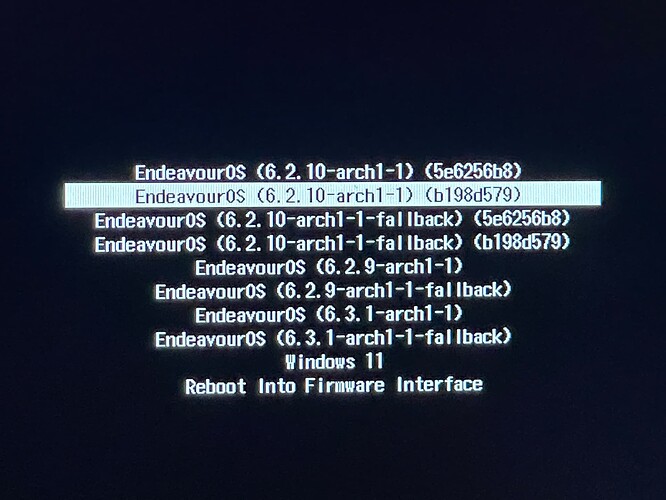Hi guys, so the instance ending in d579 and the instance that is version 6.2.9 have both had those partitions erased, yet they stay on this boot menu. If i try to boot them they just get stuck on the loading screen. How can i properly delete these ghost installs? Thanks!
Run: sudo reinstall-kernels first. Reboot and see if those entries are gone.
If not, have a look into /efi/loader/entries and remove those .conf files related to these boot entries.
How do delete these files in the terminal? it’s giving me an access denied on erasing through dolphin viewer.
![]() First be careful to identify the correct files to remove.
First be careful to identify the correct files to remove.
sudo rm /efi/loader/entries/FILE
Replace FILE with the name of the file that you have carefully identified to remove.
Looks like the version 6.2.9 is easy to spot, the other one the instance codes appear at the very beginning of the file name. Coast clear, worked like butter!
Final question on this topic, how can i rearrange the boot order menu? The top selection isn’t my daily driver and it autoboots in a few secs if I’m not quick to catch it. This isnt a bios bootloader thing, it auto loads into EOS menu and its that EOS boot menu that’s in question.
Rearranging… I don’t know.
But you can choose the loader to be default by choosing it in the boot menu and pressing d.
Also if you want to increase the time to stay in the boot screen, you can edit
/efi/loader/loader.conf
and change the value of: timeout
Beautiful! Now 1 second is the sweet spot ![]() You da man
You da man
I thought that was Shift D let me reboot and check.
Pudge
Actually, both work. d or Shift d
Pudge
Looks like it’s not case sensitive ![]()
You can set the default in /efi/loader/loader.conf as well.
Perhaps that is a more “robust” way.
But you can choose the loader to be default by choosing it in the boot menu and pressing d.
I thought that was Shift D let me reboot and check.
Actually, both work. d or Shift d
It doesn’t matter which case you choose, it isn’t a good solution either way. As soon the kernel updates it will break.
Instead you should set the default entry as described in the EOS wiki.
Instead you should set the default entry as described in the EOS wiki.
Right. I had second thoughts about it as well:
You can set the default in /efi/loader/loader.conf as well.
Perhaps that is a more “robust” way.
Also, is boootctl set-default equivalent to pressing d/D on the boot menu entry?
is
boootctl set-defaultequivalent to pressing d/D on the boot menu entry?
Probably but it might be possible to use wildcards there. I have never tested.
That being said, I think it is both cleaner and safer to edit the config file instead of writing EFI variables to the firmware.
I think it is both cleaner and safer to edit the config file instead of writing EFI variables to the firmware.
You are right. I cannot not to agree.
I cannot not to agree.
Good point, I also don’t think this statement isn’t true.
This topic was automatically closed 2 days after the last reply. New replies are no longer allowed.

